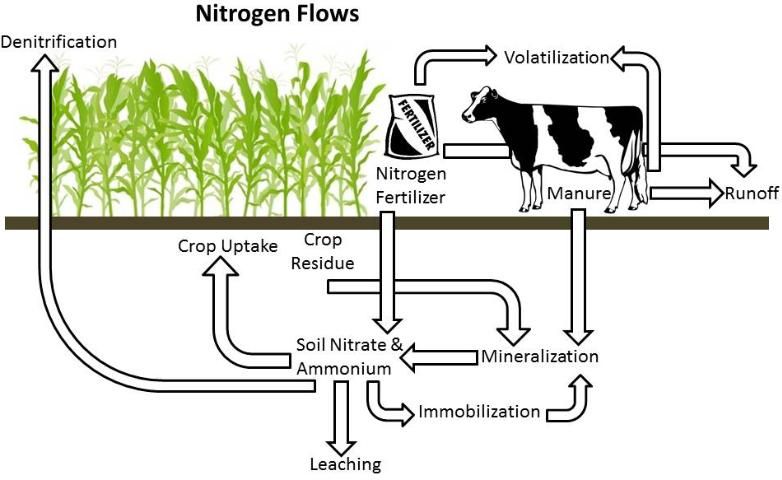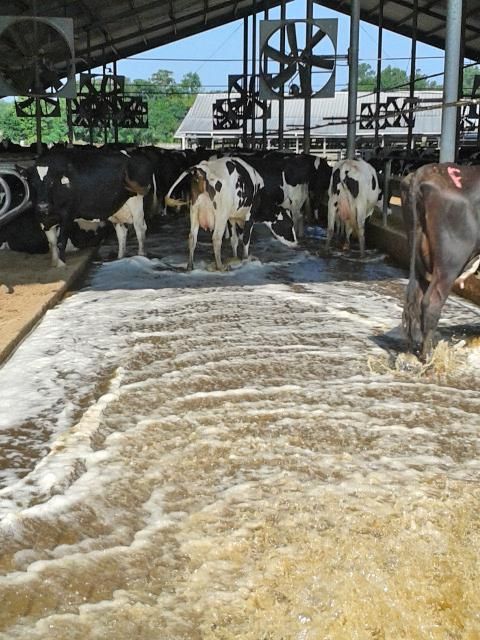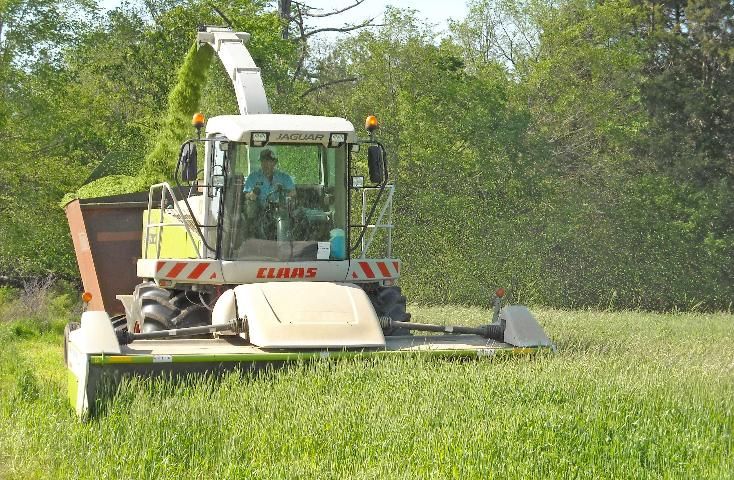Introduction
Nitrogen flows through the typical dairy production system to provide nitrogen to both forage crops and dairy cows. Dairy manure is applied to forage crops that utilize the nitrogen mineralized from the manure for plant growth. The crops are then harvested and fed to dairy cows that, in turn, use the nitrogen for their growth and milk production. The cows excrete a portion of the consumed nitrogen as manure and the cycle is renewed. This Extension publication focuses on the forage production aspect of the nitrogen cycle at a dairy farm. Nitrogen flows in a dairy forage system are characterized by inputs into the system, crop utilization, and losses from the system shown in Figure 1. It is important to fully understand these nitrogen flows in order to make management decisions which will allow crops to best utilize the nitrogen and to minimize nitrogen losses to the environment.
Nitrogen takes on many forms in its flow through the dairy forage system, from organic nitrogen in manures and plant material to inorganic forms as nitrate anions and ammonium cations in fertilizers and the soil solution. Nitrogen is highly mobile, can quickly change in form, and can be lost rapidly from the dairy forage system depending on conditions. Many environmental factors have an impact on nitrogen flows. The parts of the nitrogen cycle on a dairy farm are discussed in more detail below with the goal of understanding the cycling of nitrogen, maximizing nitrogen crop uptake, and minimizing losses.

Credit: R. Hellmuth
Inputs
Soils as a Source of Nitrogen
Soils in the forage production system provide storage of nutrients and, most importantly, supply nutrients to the roots of forage crops. Several nitrogen cycle processes take place in the soil to help increase nitrogen availability for plants or that lead to nitrogen losses. Soil testing in the southeastern US is not commonly used to measure soil nitrogen concentration due to the highly mobile nature of nitrogen in sandy soils. Instead, nitrogen applications are made based on crop needs (Mylavarapu et al. 2009). Nitrogen is added to the soil through manure, nitrogen fertilizer, and plant residue.
Mineralization and immobilization are nitrogen transformations that take place in the soil. Mineralization is the microbial process by which organic nitrogen from manure or plant residue is broken down and converted into inorganic nitrogen that is available for plant uptake. This process is highly variable and difficult to predict because it is dependent on the soil's microbial population, climatic conditions, and management practices. In general, mineralization is more rapid in warm conditions and slows in cool conditions. Management practices also affect the speed of breakdown and nitrogen release. Tilling the plant residue and manure into the soil, thus increasing soil and microbe contact, will help organic matter break down faster. Immobilization is the process by which nitrogen is consumed by microbes for their own growth and is no longer available for crop uptake, until the microbes die and the nitrogen is released by decomposition. Depending on their makeup, plant residues can cause either mineralization or immobilization of nitrogen. Residues with higher carbon to nitrogen ratios (greater than 30:1) take longer to decompose and favor immobilization of nitrogen by the microbes.
Manure Nutrients
Dairy farms have an internal source of nutrients available for forage production from dairy cow manure. Dairy manure provides a source of nitrogen, phosphorus, and potassium as well as many other essential macro and micronutrients needed for crop production. The nutrients in dairy manure come from the feed consumed by the dairy cows either through off-farm purchased animal feedstuffs or from forages grown on the dairy farm.
On concentrated dairy farms, manure commonly is collected by either a flush or scrape manure management system. In a flush system shown in Figure 2, alleys where the majority of dairy cow manure is excreted are periodically flushed with water to move manure out of the barn and into a manure management system. In a scrape system, the floor of the dairy barn is scraped periodically by a tractor to remove waste from the barn. In a scrape system manure is typically stored as a solid, whereas with the flush system manure is stored as a semi-liquid referred to as "effluent." Manure effluent is manure mixed with large amounts of water so that it is a homogenous liquid. Manure can be applied to forage crops as a nutrient source in the form of manure solids from a spreader or as manure effluent through an irrigation system. Manure nutrients are essentially "free fertilizer," with application the only cost associated with their use.
Determining the correct application rate is a challenge with manure utilization. First, nitrogen content of the manure should be known. Manure samples should be taken periodically for livestock waste analysis to determine the nutrient concentration of the manure and resulting fertilizer recommendations for forage producers. For manure sampling guidelines, the reader is referred to the Livestock Waste Test Form (Mylavarapu et al. 2013) from the UF/IFAS Analytical Services Laboratories or the Recommended Methods of Manure Analysis (Peters et al. 2003) used by Clemson University's Agricultural Service Laboratory. Second, it is unlikely that the N-P-K nutrient analysis of manure matches the same proportional nutrient needs of the crop. For example, if manure is applied based on nitrogen recommendations, phosphorus may be applied in excess of crop needs. Because the nutrients in manure cannot be separated from each other, agricultural soils with multiple years of manure application may be overloaded with nutrients such as phosphorus. A third challenge with manure utilization is that not all nutrients in manure are immediately available upon application for use by the crop. Flush manure has a large portion of the nitrogen in the ammonia form, but organic nitrogen in manure must be mineralized before the nutrients are available for plant uptake. For more information on utilization of dairy manure in cropping systems, the reader should consult "Land Application of Dairy Manure" in the Confined Animal Manure Managers Certification Program Manual (Camberato 2004).
Manure utilization costs are those of collection, storage, and application of manure to forage crops. The continuous excretion of manure by dairy cows provides a year-round supply of manure even though year-round application of manure is not always needed. Manure should not be applied to fields with no actively growing crops because of possible environmental losses due to leaching or runoff. Also, manure should not be applied if rainfall is expected. Manure application should be appropriately timed to provide available nutrients for crop needs. Fertilizer recommendations for manure utilization according to specific crop needs can be obtained from Livestock Waste Testing reports available from university labs and Extension services.

Credit: R. Hellmuth
Nitrogen Fertilizer
In addition to nutrients supplied by manure, nitrogen fertilizer also can be used as a source of nutrients for forage production. Nitrogen fertilizer must be purchased off the farm, so the cost of the fertilizer and application costs must be considered. Many forms of nitrogen fertilizer are available in either granular or liquid forms. The most common forms are urea, ammonium nitrate, and ammonium sulfate. Most nitrogen fertilizers are composed of inorganic nitrogen that is readily available to crops upon application. This is an advantage compared with manure application, because nitrogen fertilizers add a known amount of immediately available nitrogen to the soil. Nitrogen alone can be applied when phosphorus and potassium are not needed. Like manure applications, nitrogen fertilizers should be applied at times when plant growth is active and weather conditions are favorable.
Outputs
Crop Uptake
Plants take up nitrogen from the soil for growth and development. Crop uptake of nitrogen is the preferred flow of nitrogen in a forage production system, because nitrogen is used to produce a valuable feed for livestock (Figure 3.). Nitrogen is used to form the amino acids and proteins that will affect the nutritional value of the forage crops as animal feed. Dairy farmers will get the best economic return if crop uptake of nitrogen is maximized. Not only does this benefit the farmer's yield, but it will decrease negative environmental impacts from farming.
It is important to consider the rate, timing, placement, and source of nitrogen applied to crops through manure or inorganic nitrogen fertilizers in order to adequately supply plant roots with nitrogen. Farm equipment, farm labor, weather, fertilizer availability, and cost may limit these factors. Crops utilize nitrogen throughout their growth stages, but it is particularly important for plants to have adequate nitrogen available during early vegetative growth. Timing manure and nitrogen fertilizer applications so that nitrogen is available for crop uptake during certain growth stages is important for good yields. Manure applications may need to be made to a previous crop in order to ensure nutrients are available (due to mineralization) to the current forage crop when it reaches vegetative growth.

Credit: A. Crouch
Leaching
When nutrients are not taken up by crops, these nutrients may be lost to leaching from the root zone of the crop. Leaching is caused when the gravitational pull on saturated soils causes soil water to move downward. Because nitrate-nitrogen is highly mobile in the soil, especially sandy soil, it is easily lost with the leached soil solution. Timing, rate, and placement of application of manure and nitrogen fertilizers are important to reduce leaching losses. Nitrogen fertilizers and manure applications should be avoided when a large rainfall is predicted. Irrigation also should be timed to prevent saturated soils and subsequent leaching losses. Splitting application of fertilizers can avoid nitrogen leaching losses because it gives the crop more time to take up the nitrogen before it may be lost to leaching. Timing and amount of nitrogen should be determined according to the crop's nitrogen demand. Nitrogen losses may be reduced by applying the nitrogen to fit the crop's need, by placing nitrogen fertilizer close to the roots of plants, and by increasing soil's water-holding capacity by building organic matter.
Runoff
Like leaching, runoff can cause losses of nitrogen from a forage production system due to water movement across a field. If the infiltration rate of the soil is not adequate to handle the volume of water applied, runoff will occur, especially if the field is sloped. Nitrogen may be lost through manure or fertilizer particles physically moving off the field or by nitrogen in the soil solution being carried by runoff. Runoff can be reduced by several methods including not applying manure effluent or fertilizer prior to predicted rainfall, carefully scheduling irrigation, and applying manure effluent in smaller amounts that will not saturate the soil surface. Leveling the field or decreasing slope, increasing soil permeability by breaking up soil crusts (tilling), increasing the soil infiltration rate by improving soil structure, and increasing surface residue cover will decrease the movement of water off the field. Incorporating fertilizer in the soil can prevent nutrients from being carried with runoff.
Volatilization
Volatilization is the process by which nitrogen changes from ammonium-nitrogen to ammonia gas which can be lost to the atmosphere. In forage production systems, volatilization typically occurs during the application of manure or urea or urea-containing fertilizers to forage crops, especially if applied to the surface of warm, moist, high-pH (>7.0) soils. Flushed manure has a large portion of the nitrogen in the ammonia form which is susceptible to volatilization. Typically in the southeastern US, when manure is applied to a forage production system, it is assumed that 50 percent of nitrogen from manure effluent is lost to volatilization (Van Horn et al. 1994). To minimize volatilization losses, it is recommended that manure/ammonium-nitrogen fertilizer be incorporated or injected into the soil. These methods of minimizing volatilization losses generally are limited to manure solids applied before planting. Urease inhibitors can be used to decrease volatilization losses with urea fertilizers.
Denitrification
Denitrification is a gaseous loss of nitrogen from the soil and the forage production system. Denitrification is a microbial process by which soil nitrate-nitrogen is converted to nitrogen gas under anaerobic (no oxygen) soil conditions. High rates of denitrification are not likely in well-aerated, sandy soils. Dairy farmers should try to prevent denitrification by timing irrigation not to coincide with rainfall to prevent ponding or saturated conditions in soils, maintaining ditches to ensure proper drainage from the field, or in extreme cases, installing tile drainage to remove excess water from fields.
Take-Home Lessons
Nitrogen is an important nutrient for forage crop production on a dairy farm and undergoes a complex cycle of inputs and outputs on the farm. The challenge for the dairy farmer is to understand the nitrogen flows and manage nitrogen so that it benefits crop production and is not lost from the farm. Some important nitrogen management aspects are:
- Manure should be regularly tested to determine its organic and inorganic nitrogen composition.
- Mineralization of organic matter is dependent on many factors, but generally is more rapid during warm conditions and slower during cool conditions.
- Manure and nitrogen fertilizer should be applied based on crop needs and timed so that inorganic nitrogen is available to crops as the growth cycle demands it.
- Manure and nitrogen fertilizer should not be applied if rainfall is predicted.
- Manure applications which lead to excessive loading of a particular nutrient should be avoided.
- Nitrogen losses are minimized when crop uptake of nitrogen is maximized. Dairy farmers benefit economically from crop uptake of nitrogen through greater yield and better nutritional content of forage.
- Correct timing, rate, placement, and source of manure and fertilizer can reduce losses from leaching, runoff, volatilization, and denitrification.
References
Camberato, J. 2004. "Land Application of Dairy Manure." In Confined Animal Manure Managers Certification Program Manual: Dairy Version 1. Clemson, SC: Clemson University Cooperative Extension Service. http://www.clemson.edu/extension/livestock/camm/camm_files/dairy/dch5a_03.pdf.
Mylavarapu, R., D. Wright, G. Kidder, and C. G. Chambliss. 2013. UF/IFAS Standardized Fertilizer Recommendations for Agronomic Crops. SL129. Gainesville, FL: University of Florida Institute of Food and Agricultural Services. https://edis.ifas.ufl.edu/ss163.
Mylavarapu, R., W. d'Angelo, and N. Wilkinson. 2013. Livestock Waste Testing Form. SL397. Gainesville, FL: University of Florida Institute of Food and Agricultural Services. https://edis.ifas.ufl.edu/ss599.
Peters, J., S. Combs, B. Hoskins, J. Jarman, J. Kovar, M. Watson, A. Wolf, and N. Wolf. 2003. Recommended Methods of Manure Analysis A3769. Board of Regents of the University of Wisconsin System, Cooperative Extension Publishing Operations.
VanHorn, H., A. Wilkie, W. Powers, and R. Nordstedt. 1994. "Components of Dairy Manure Management-Systems. J. Dairy Sci. 77:2008–2030.

